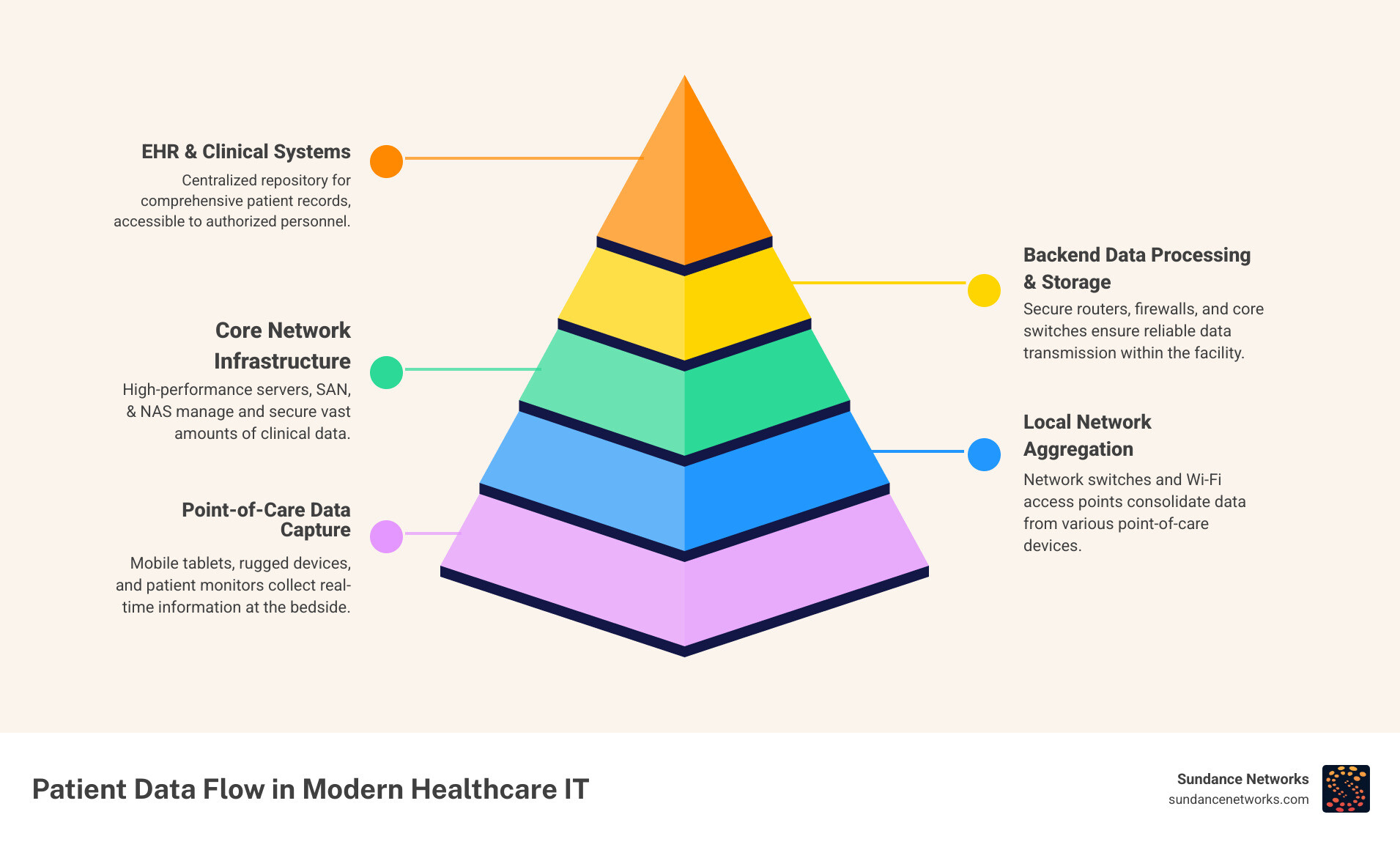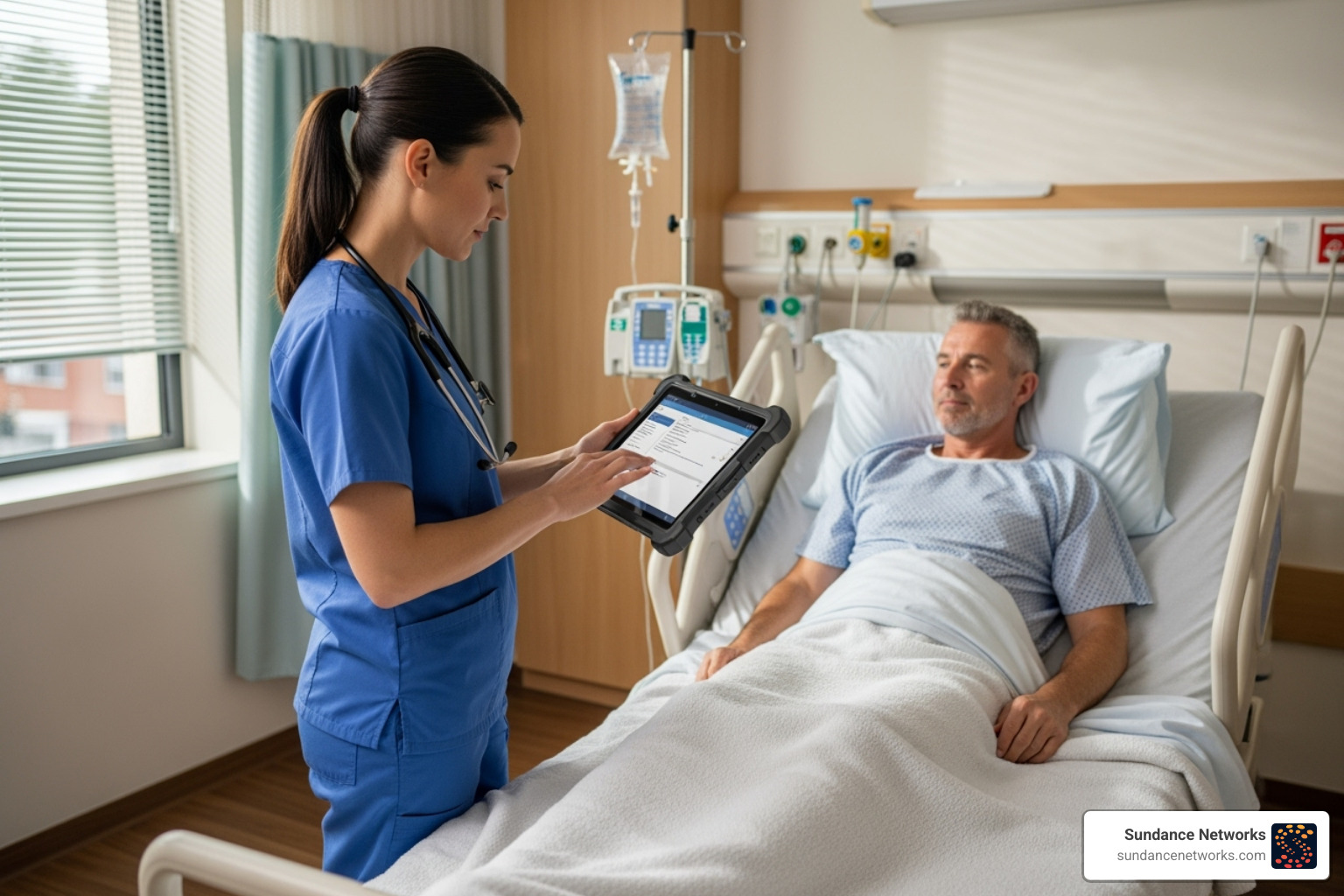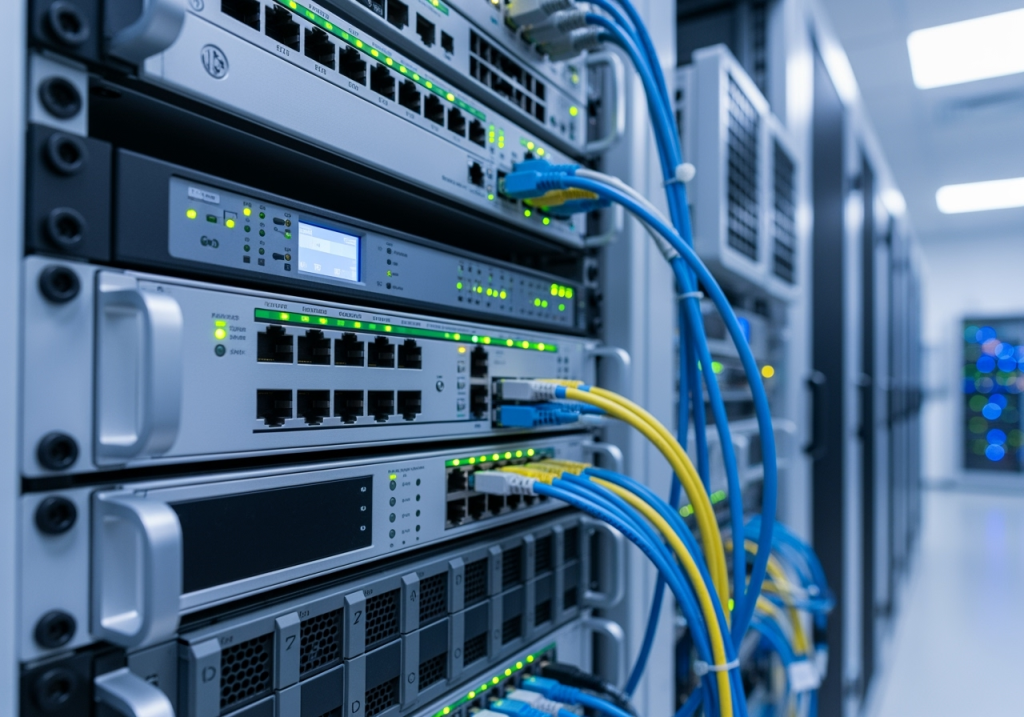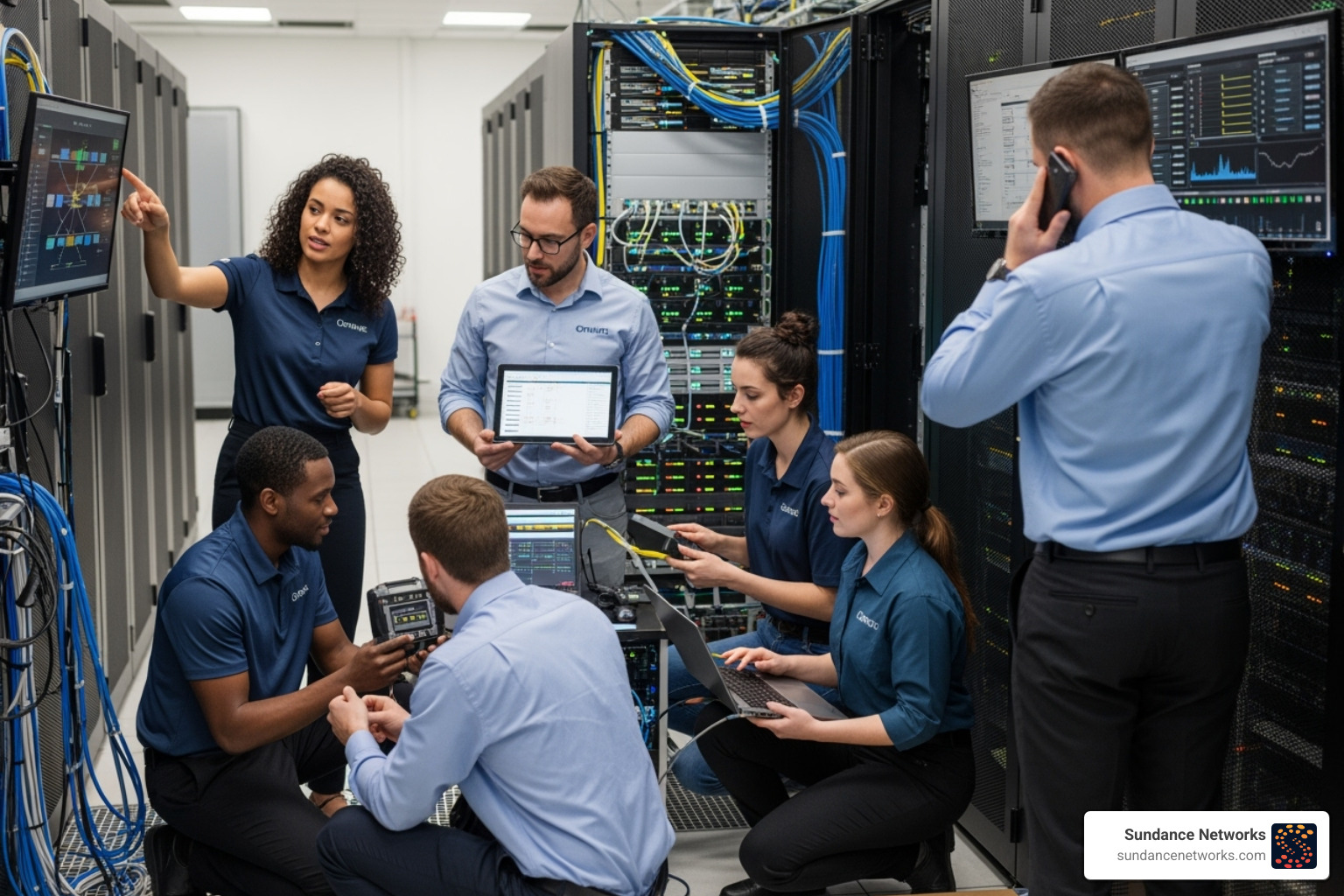Healthcare IT hardware is the critical foundation for modern medical facilities, powering everything from patient registration to life-saving diagnostic equipment. These physical components—servers, workstations, mobile devices, and specialized medical equipment—are essential for delivering safer, more efficient patient care while managing vast amounts of sensitive health data.
The impact of proper hardware is immense. Research shows that computer hardware use in healthcare can reduce medical errors by up to 80%, and improved operational efficiencies could generate savings of $77 billion annually.
However, selecting and managing healthcare IT hardware presents unique challenges. It must meet stringent medical-grade specifications, comply with HIPAA, withstand frequent sanitization, and operate reliably in life-critical situations. A hardware security failure, like the ransomware attack on Dusseldorf University Hospital that resulted in a patient’s death, can have devastating consequences.
I’m Ryan Miller, founder of Sundance Networks. With over 17 years in IT and a decade specializing in information security, I help healthcare organizations steer the complex intersection of medical requirements, regulatory compliance, and technology to build resilient, secure IT infrastructures.

The Core Components: Essential Hardware in Today’s Healthcare
A modern hospital’s healthcare IT hardware works like an orchestra, with each component playing a crucial role in delivering safe, efficient patient care. Investing in the right hardware builds the foundation for better patient outcomes. Servers act as the digital heart, pumping patient data and applications like Electronic Health Records (EHRs) throughout the system. Data storage systems serve as a vast medical library, holding everything from X-rays to lab results.
Daily workflows depend on workstations where clinicians review charts and manage billing, often handling massive medical imaging files. Networking equipment creates the invisible highways that carry this critical information at high speed. Unique to healthcare is the need for mobile devices that move with the care team, providing instant access to test results or allergy information. The most specialized category is medical-specific hardware, which must meet strict FDA regulations and withstand constant cleaning.
For organizations looking to upgrade their technology, we offer comprehensive solutions custom to healthcare’s unique needs. Learn more about our hardware solutions and how we can build your digital foundation.
Point-of-Care Hardware
Point-of-care hardware brings computing power directly to the bedside, revolutionizing clinical workflows.
- Mobile carts (COWs/WOWs): These rolling workstations bring full computing power to patients, with batteries that can last over 36 hours to prevent interruptions during critical moments.
- Rugged tablets: Built to survive drops and harsh sanitization, these devices are perfect for quick medication checks and accessing medical references on the go.
- Handheld scanners: These devices are patient safety heroes, enabling Barcode Medication Administration (BCMA) to ensure the right patient gets the right medication, dramatically reducing errors.
- Wall-mounted computers: Ideal for cramped patient rooms and sterile operating theaters, these sealed units provide easy access to EHRs where they’re needed most.
- Patient monitoring devices: This critical hardware continuously tracks vital signs, alerting staff to dangerous changes and integrating with EHRs to eliminate manual data entry errors.
Backend Infrastructure Hardware
Behind the scenes, backend infrastructure does the heavy lifting. High-performance servers process thousands of simultaneous requests, handling massive medical imaging files and running clinical applications. They must be powerful enough for a radiologist to compare current and past studies in seconds.
Network-Attached Storage (NAS) and Storage Area Networks (SAN) manage the terabytes of new data generated monthly, ensuring it’s protected and instantly available. The networking equipment connecting everything requires special consideration, as hospital networks carry life-critical information. Our team specializes in network router configuration that prioritizes this critical traffic.
Healthcare organizations must also decide between on-premise and cloud hosting, a choice that impacts hardware and costs. We help clients steer the on-premise or cloud decision based on their specific needs.
Specialized Medical and Imaging Hardware
The most impressive healthcare IT hardware often combines medical technology with powerful computing. MRI machines, CT scanners, and ultrasound systems are sophisticated computers that capture detailed images and rely on powerful processors to reconstruct them for diagnosis.
Diagnostic ECG equipment has evolved into connected systems that integrate with EHRs, allowing physicians to compare heart rhythms over time. Digital imaging workstations are among the most demanding applications, requiring high-end Graphics Processing Units (GPUs) to handle 3D renderings and massive image files with perfect clarity, as subtle differences can impact a diagnosis. These workstations also support AI-assisted diagnosis, which requires significant computing power.
How the Right Healthcare IT Hardware Transforms Patient Care
The true value of healthcare IT hardware is its direct impact on patient care. It’s about creating seamless, reliable systems that empower providers and improve outcomes.

When organizations invest in the right hardware, the change is immediate. Clinical workflows improve with real-time data access, EHR support becomes rock-solid, and medical imaging access speeds up diagnoses. This technology also enables telemedicine and boosts patient engagement by empowering individuals in their own healthcare journeys.
Enhancing Clinical Workflows and Efficiency
Real-time data access at the bedside changes everything. Clinicians with mobile carts or tablets can make faster, more confident decisions without hunting for paper charts. This shift also streamlines administrative tasks, as digital charting eliminates hours of paperwork, allowing staff to focus more on patient care.
Barcode medication administration (BCMA) is a major safety advance. Using handheld scanners, nurses verify the “five rights” of medication administration, and studies show this can reduce medical errors by up to 80%. Furthermore, streamlined communication through secure messaging and VoIP phone systems enables care teams to coordinate seamlessly.
The financial impact is significant. A RAND Corp. analysis estimated that improved operational efficiencies could save $77 billion annually. A smart IT strategy is essential for any healthcare organization that wants to thrive. Learn more about The Managed IT Necessity: Why Your Business Needs a Smarter IT Strategy.
Supporting Critical Clinical Applications
Healthcare IT hardware is the foundation for medicine’s most critical applications.
- Electronic Health Records (EHRs) depend on a symphony of hardware: robust servers for processing, high-speed networks for access, and reliable workstations for data entry. Solid-state drives are popular for their ability to access patient data in seconds.
- Picture Archiving and Communication Systems (PACS) present even greater challenges due to enormous medical imaging files. PACS require powerful workstations with advanced GPUs for analysis and massive storage solutions to keep images accessible for years.
- Telemedicine and remote patient monitoring rely on specialized hardware. High-quality cameras and microphones enable clear video consultations, while wearable sensors transmit vital signs securely. Research on smart home systems for health assessments shows the potential for remote monitoring to help patients manage their health independently.
Selecting and Managing Hardware: A Blueprint for Healthcare Organizations
Choosing the right healthcare IT hardware is a balancing act between patient safety, regulatory compliance, and budget. In healthcare, this foundation directly impacts patient lives.

Key considerations go far beyond what other industries face. Reliability and uptime are about patient safety, not just productivity. Security and compliance with HIPAA are non-negotiable. The total cost of ownership (TCO) includes maintenance, training, and disposal, often surprising leaders who only see the sticker price. Smart IT Budget Planning is crucial. Additionally, hardware must withstand infection control protocols and be scalable to grow with your organization. A strategic IT Asset Management Lifecycle is essential to manage these factors.
Key Selection Criteria for Healthcare IT Hardware
Shopping for healthcare IT hardware requires a specialized checklist that prioritizes clinical needs.
- Medical-grade specifications: These devices are tested for electromagnetic interference and electrical safety, ensuring they operate reliably near other medical equipment.
- Durability and ruggedness: Devices like rugged tablets are built to handle the drops, spills, and constant cleaning of a busy clinical environment.
- Battery life: Mobile devices with 36+ hours of battery life prevent interruptions during long shifts, ensuring clinicians always have access to the tools they need.
- Antimicrobial properties: Many medical-grade devices feature plastics or coatings that inhibit bacterial growth, making them safer and easier to clean.
- Power-over-Ethernet (PoE): PoE simplifies installation and reduces cable clutter by delivering power and network connectivity through a single Ethernet cable.
The Critical Role of Hardware in Data Security and HIPAA
Healthcare IT hardware is the first line of defense in protecting patient data. Hardware-level encryption on drives ensures that data on a lost or stolen device remains inaccessible. Biometric authentication, like fingerprint scanners, eliminates the risks of shared or weak passwords. Secure boot processes prevent malware from loading at the system’s deepest levels.
These features are critical in defending against constant cyber threats, especially ransomware. These attacks can shut down hospital operations, and as the news of a death following an attack on Dusseldorf University Hospital shows, the consequences can be fatal. Our HIPAA Compliance Consulting helps organizations build layered security strategies to mitigate these risks while maintaining clinical accessibility.
The Future is Now: How Emerging Tech is Shaping Hardware Needs
The pace of change in healthcare technology has never been faster, and the implications for healthcare IT hardware are profound. Technologies that once seemed like science fiction are now reshaping patient care.

We’re seeing a convergence of Artificial Intelligence (AI) in diagnostics, 5G connectivity for real-time remote procedures, the Internet of Medical Things (IoMT) for continuous patient monitoring, and edge computing for point-of-care processing. These trends are fundamentally changing hardware requirements, and at Sundance Networks, we help clients steer these shifts with Future-Proof Technology solutions.
AI, IoT, and 5G: The Next Wave of Hardware Demands
This technological convergence creates new hardware needs. Powerful GPUs for AI processing are becoming essential for tasks like medical imaging analysis, where algorithms process millions of data points to detect diseases earlier. We help organizations implement AI Solutions that leverage this powerful hardware.
Low-latency 5G-enabled devices are enabling remote-guided surgeries and real-time transmission of high-definition video from ambulances. The Internet of Medical Things (IoMT) is creating networks of sensors and gateways that monitor patients continuously. To handle this data explosion, edge servers for real-time analytics are becoming crucial. Edge computing processes information locally, enabling faster alerts and reducing network strain.
Latest Innovations and Trends
Today’s hardware innovations are genuinely transformative.
- Wearable biosensors have evolved to monitor blood glucose, detect irregular heart rhythms, and even predict seizures, requiring highly efficient and secure hardware.
- VR/AR for surgical training allows medical students to practice complex procedures in realistic virtual environments, demanding high-resolution displays and powerful graphics processing.
- 3D printing in healthcare has become essential for creating custom prosthetics and surgical guides, using specialized printers that meet strict medical-grade standards.
- Robotic-assisted surgery systems combine precise mechanical control with advanced imaging and AI, allowing for minimally invasive procedures with improved precision.
- Smart hospital infrastructure ties these innovations together, from intelligent lighting to automated medication dispensing, all requiring a sophisticated, reliable, and secure hardware backbone.
Frequently Asked Questions about Healthcare IT Hardware
When it comes to Healthcare IT hardware, we get a lot of questions from healthcare leaders. Here are answers to the most common concerns.
What is the primary role of computer hardware in healthcare?
Healthcare IT hardware is the physical backbone for all digital health operations. Its primary role is to enable the secure and efficient collection, storage, processing, and retrieval of patient data. This includes powering Electronic Health Records (EHRs), enabling complex medical imaging analysis, supporting AI-driven diagnostics, and facilitating communication between care teams. It provides the foundation for safer, more effective patient care.
How does hardware selection impact patient safety?
Hardware choices directly impact patient safety in several critical ways. First, it helps reduce medical errors through systems like barcode scanners for medication administration, which can cut errors by up to 80%. Second, reliable hardware ensures constant access to vital patient data like allergies and lab results, preventing delays in care. Finally, medical-grade devices are designed for easy sanitization, helping to control the spread of infections within clinical environments.
What are the main challenges of managing healthcare IT hardware?
Managing Healthcare IT hardware involves several unique challenges.
- High Total Cost of Ownership (TCO): Costs extend beyond the initial purchase to include maintenance, support, training, and secure disposal.
- Cybersecurity Threats: Healthcare is a prime target for attacks like ransomware, which can disrupt operations and endanger patients. Protecting data requires hardware-level security features and constant vigilance.
- Complex Integration: New hardware must integrate seamlessly with a mix of modern and legacy systems, which can be technically challenging.
- Regulatory Compliance: All hardware and processes must adhere to strict HIPAA regulations to protect patient privacy.
- Lifecycle Management: Planning for the entire hardware lifecycle, from procurement to secure disposal, is essential for optimizing investments and minimizing risk.
Conclusion: Building a Resilient and Future-Ready Health System
As we’ve seen, healthcare IT hardware is more than just technology; it’s the digital lifeline of modern medicine. From backend servers powering EHRs to rugged tablets at the bedside, each component is critical to the symphony of patient care.
A strategic approach to selecting and managing this hardware is essential. It requires balancing cost, security, and innovation to protect patient data, stay ahead of the technological curve, and manage the total cost of ownership. Defending against ransomware and integrating new systems are real, high-stakes challenges.
This is where Sundance Networks provides expert guidance. Our IT Consulting and System Integration services are designed to help healthcare organizations steer these complexities. Whether you’re a clinic in Santa Fe or a larger facility in Reading, we have the experience to help.
Emerging technologies like AI and IoMT are reshaping hardware needs. Organizations that view their hardware strategy as a core investment in patient outcomes will be the ones that thrive. A strong hardware foundation enables faster diagnoses, fewer errors, and better care.
For a comprehensive assessment of your technology needs and to ensure your healthcare IT hardware is ready for today’s demands and tomorrow’s innovations, explore our Hardware solutions or contact us.
Sundance Networks
Phone: (575) 758-9709
Service Locations: Santa Fe, NM; Stroudsburg, PA; Reading, PA






